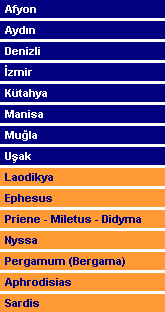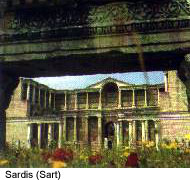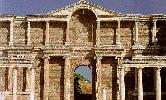| Sardis... |
|
The site of ancient Lydian capital of Sardis is located near the present-day village of Sart
in the province of Manisa. The ruins are located on either side of the Ankara-Izmir highway,
72 kilometers from Izmir. Excavations conducted by Americans at Sardis in 1910-14 unearthed
the Temple of Artemis and more than a thousand Lydian tombs. The works that they brought to
light are now in the New York Metropolitan Museum.
Excavations under the direction of an American team are still in progress at Sardis and there
are four principle areas now that may be visited: the Sardian acropolis, the ancient city
located around it and along the highway, the valley of the Paktalos River (Sart Çay›),
and the tombs at Bintepe. We will start our tour with the ruins by the highway. Immediately
by the highway are the imposing ruins of a gymnasium and baths to which a synagogue was added
at a later time. The complex is entered through a door located in the center of the eastern
section. This door leads into a colonnade-encircled open courtyard. This courtyard connects
to the synagogue located on the north and served as the gymnasium's palaestra. On the northern
side of the courtyard are rooms used for instruction and training.
From inscriptions that have been turned up in excavations, we know that the decorative eastern
facade of the gymnasium was built during the reign of the emperors Caracalla and Geta (around
the beginning of the 3rd century AD). Taking advantage of the fragments found here, the
gymnasium's facade has been successfully restored. The baths were entered through doors opening
into the courtyard. Originally built in 161 AD during the reign of Lucius Verus, they underwent
major repairs in 211. The synagogue and eastern section of the baths were restored between 1964
and 1973. The main street of the city stretched along the southern sides of the synagogue and gymnasium.
Paved with huge marble blocks, there were shops located on either sides of this street. On the
southern side of this marble street there where colonnades that where built in the 4th century
AD but they now lie beneath the asphalt road. The shops on the northern side of the street and
those along the southern side of the synagogue and gymnasium are from the Byzantine period. On the other side of the highway opposite the gymnasium is a huge structure called the
"Bronze House of the Infidels". Excavations that have been conducted here have turned
up numerous bronze works of a religious nature.
|
|

|







